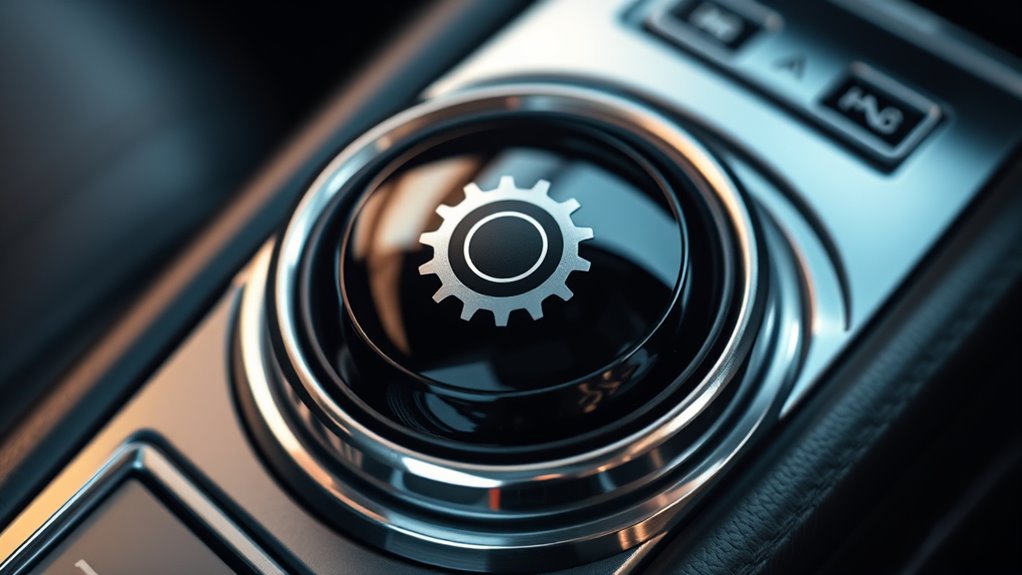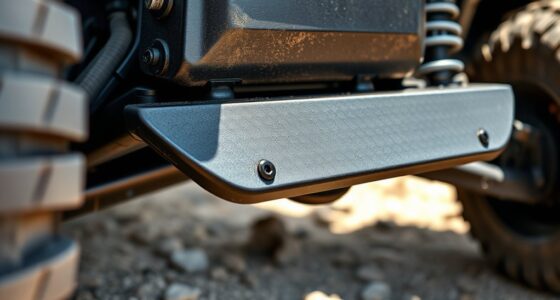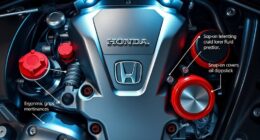To improve gear shift efficiency, focus on smooth clutch control and gentle, deliberate shifting. Avoid abrupt or hesitant movements that cause extra wear or jerks. Make use of your vehicle’s synchronized gears and advanced transmission features to ease shifts. By mastering proper technique, you’ll enjoy smoother drives, better fuel economy, and longer vehicle life. Keep paying attention to your gear changes, and you’ll discover more ways to optimize your driving performance.
Key Takeaways
- Proper clutch control ensures smooth gear changes, reducing wear and improving overall efficiency.
- Synchronization in transmission design facilitates effortless shifts and minimizes power loss.
- Advanced transmission systems automate gear engagement, enhancing shift smoothness and driving comfort.
- Gentle, deliberate shifting habits maximize transmission lifespan and fuel economy.
- Skillful clutch handling and vehicle familiarity lead to more efficient, comfortable driving experiences.

Have you ever wondered how smoothly your vehicle shifts gears and how that impacts overall efficiency? The secret often lies in clutch control and transmission design. When you operate a manual transmission, clutch control is your primary tool for ensuring seamless gear changes. Proper clutch control means you’re engaging and disengaging the clutch pedal with just the right amount of pressure and timing, preventing jerkiness and undue wear. If you slip the clutch too much or too quickly, it can cause unnecessary friction and reduce efficiency. Conversely, if you’re too abrupt or hesitant, it can lead to rough shifts and increased fuel consumption. Mastering clutch control allows you to make smooth, precise gear changes, which not only prolongs the life of your clutch but also *maximizes* power transfer from the engine to the wheels.
Transmission design plays a *vital* role in how effortlessly your vehicle shifts gears. Modern transmissions are engineered to reduce the effort required for smooth shifts and to improve overall efficiency. For example, many designs incorporate synchronized gears that match rotational speeds before engagement, making gear changes less jerky and more predictable. Advanced transmission systems, like dual-clutch or automatic transmissions, further enhance shift smoothness by automating clutch engagement and gear selection. These systems are carefully designed to minimize power loss during shifts, ensuring that your vehicle operates at *peak* efficiency. When the transmission design prioritizes seamless engagement, you experience less driver fatigue and better fuel economy, especially during stop-and-go traffic or long highway drives. Additionally, innovations like sound design in transmission systems are increasingly used to create a smoother and more refined driving experience.
Your driving habits also influence how well clutch control and transmission design work together. Gentle, deliberate shifting allows the transmission’s engineering to shine, while aggressive or hurried shifts can put unnecessary strain on the system. Recognizing the importance of precise clutch control and understanding your vehicle’s transmission design helps you achieve *ideal* shift efficiency. Over time, as you become more familiar with your vehicle’s characteristics, you’ll notice smoother gear changes, better acceleration, and improved fuel economy. This combination of skillful clutch handling and the right transmission design ultimately makes your driving experience more comfortable, efficient, and longer-lasting.
Frequently Asked Questions
How Does Beta Compare to Traditional Gear Shifting Methods?
Beta improves upon traditional gear shifting methods by offering manual optimization, allowing you to fine-tune gear changes for better efficiency. It adapts to your driving style, enhancing driver adaptability and comfort. Unlike conventional systems, Beta’s advanced algorithms ensure smoother, quicker shifts, reducing wear and tear. This makes your driving experience more responsive and efficient, helping you save fuel and extend your vehicle’s lifespan through smarter gear management.
Can Beta Be Integrated Into Existing Vehicle Models Easily?
You can integrate Beta into your existing vehicle models, but it requires careful attention to hardware integration and software compatibility. You’ll need to update or adapt the vehicle’s control systems to support Beta’s technology, which might involve installing new sensors or controllers. Ensuring seamless communication between Beta’s software and your vehicle’s hardware is vital for smooth operation, making the integration process manageable with proper planning and technical support.
What Are the Cost Implications of Implementing Beta Technology?
Cost concerns create complications, but careful cost analysis clarifies the cost implications of beta technology. You’ll face investment costs for integration, including equipment upgrades and testing. While initial expenses may seem high, the long-term savings from improved efficiency and performance can offset these costs. You’ll want to weigh the upfront investment against potential benefits, ensuring your budget balances both basic expenses and bold advancements for better gear shift efficiency.
How Does Beta Impact Vehicle Maintenance Requirements?
Beta technology can improve your vehicle’s maintenance by reducing wear and tear on components like the transmission, thanks to smoother gear shifts. This leads to better fuel efficiency and less frequent repairs. You might notice fewer issues with the clutch or gearbox, saving you money over time. Overall, integrating beta technology helps maintain your vehicle’s performance while lowering maintenance costs and enhancing reliability.
Are There Any Safety Concerns With Using Beta Gear Shift Systems?
Yes, there are safety concerns with using beta gear shift systems. You should follow safety protocols carefully to prevent accidental shifts, which can cause accidents. In emergency response situations, make certain you’re trained to handle the system properly, as improper use might delay critical actions. Regular maintenance and clear instructions help minimize risks, making sure you can operate the system safely and respond effectively during emergencies.
Conclusion
So, when you master gear shift efficiency, you’re not just saving a few drops of fuel—you’re revolutionizing your entire driving experience. Imagine effortlessly gliding through gears so smooth, it feels like you’ve uncovered the secrets of the universe itself. Every shift becomes a symphony of precision, propelling you faster, farther, and more effortlessly than you ever thought possible. Embrace this knowledge, and suddenly, you’re not just driving—you’re commanding the road with unstoppable power and finesse.









